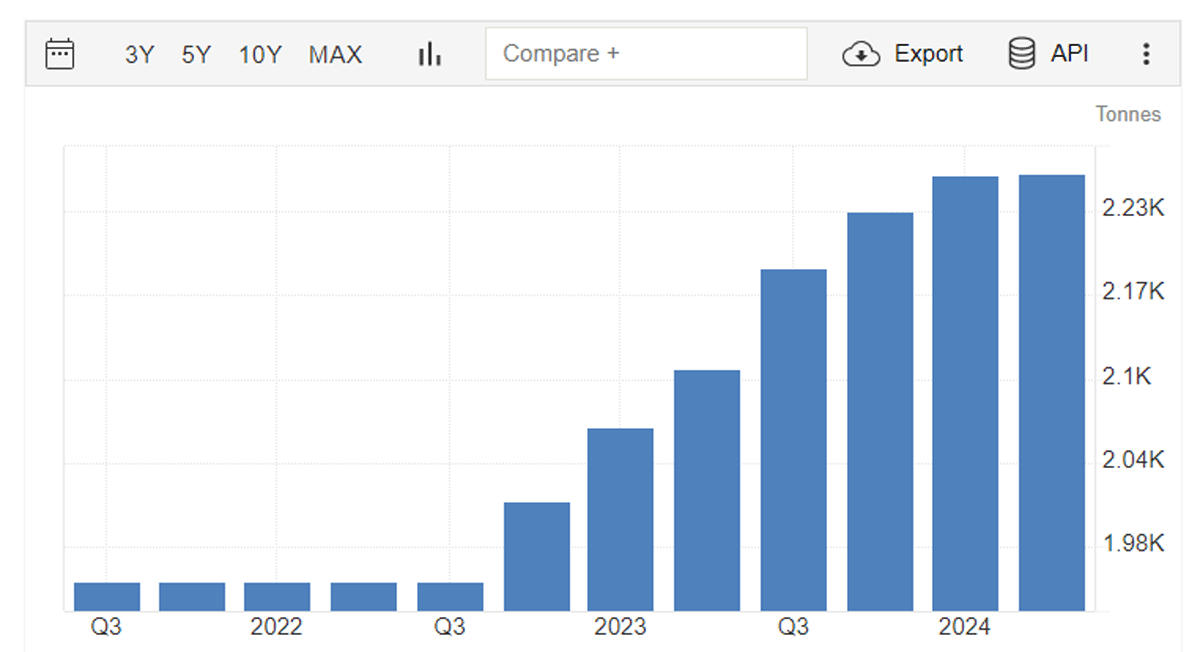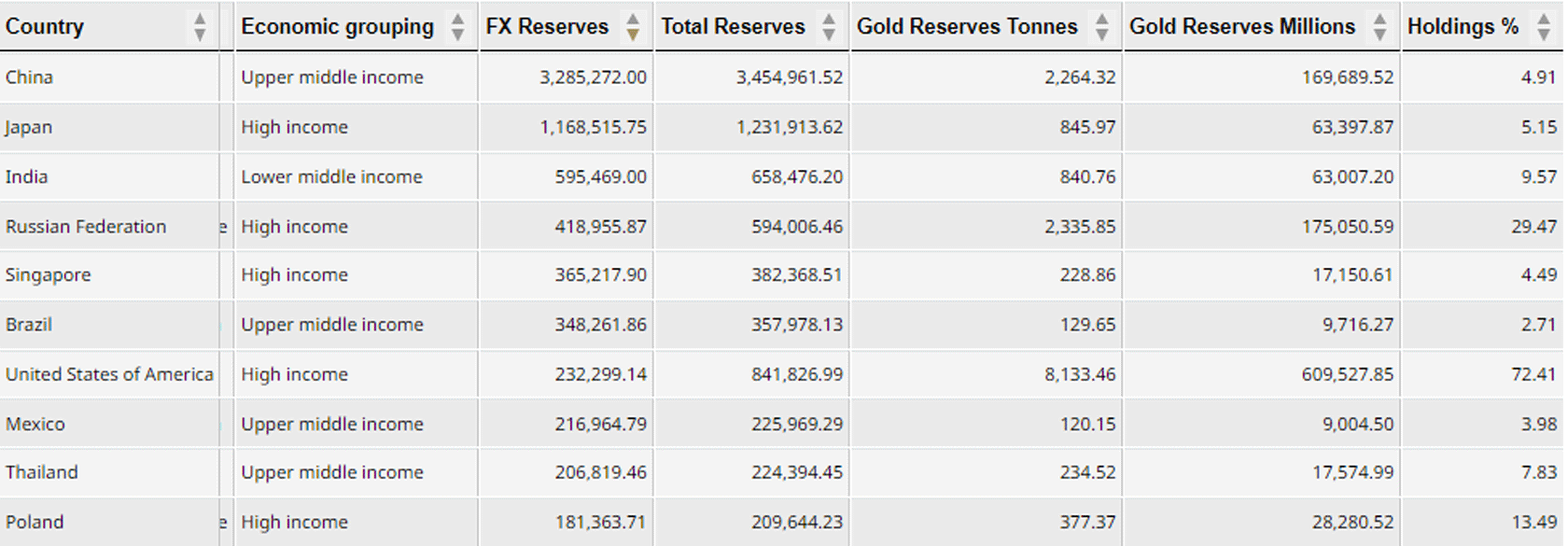Share
Homepage
News
The U.S. Holds the Largest Gold Reserves, Russia and China Rush to Buy Cheap Gold Amid Frenzy, Southeast Asia Remains Indifferent?
The U.S. Holds the Largest Gold Reserves, Russia and China Rush to Buy Cheap Gold Amid Frenzy, Southeast Asia Remains Indifferent?
29 tháng 8 2024
The U.S. Leads the World in Gold Reserves. Russia, China, and India Rush to Buy Gold Before Prices Hit Historic Highs. How Are Southeast Asian Countries Responding to Gold Imports and Reserves?
In August 2024, global gold prices surged dramatically, repeatedly setting new records. Gold futures prices at times reached $2,570 per ounce, while spot gold prices soared above $2,530 per ounce, significantly higher than the $1,820 per ounce level seen in October 2023.
So how did countries take advantage of low prices to buy gold, and how much gold do they currently hold? What is the proportion of gold in their total national reserves?
Countries Rush to Buy Gold Before Prices Skyrocket
According to the World Gold Council (WGC), the People's Bank of China (PBoC) continued to hold off on gold purchases in July. This marked the third consecutive month that the PBoC refrained from adding to its gold reserves, during a period when gold prices were at their highest levels ever recorded.
Previously, the People's Bank of China made a rare record by purchasing gold for 18 consecutive months, pushing the value of gold holdings in its national reserves to a record high—approximately 4.9%, or over 2,264 tons of gold. The total value of gold held by the PBoC is around $170 billion, compared to over $3.285 trillion in total foreign exchange reserves, representing 5.1% of its forex reserves.
China’s gold holding ratio is at a record high but remains lower than many other nations and below the global average of 16%, according to Reuters.

The People's Bank of China Holds Over 2,264 Tons of Gold, Valued at Approximately $170 Billion. Source: TE
Russia has been one of the countries that have significantly ramped up gold purchases over the past several years, particularly after facing numerous sanctions. According to the World Gold Council (WGC), by the end of Q2 2024, Russia's gold reserves accounted for nearly 29.5% of its total national reserves, which are valued at approximately $594 billion. The value of Russia's gold holdings is estimated at around $175 billion, equivalent to nearly 2,336 tons of gold.
The United States is the world’s largest holder of gold, with around 8,133 tons, valued at nearly $610 billion.
India holds nearly 841 tons of gold, valued at approximately $63 billion, which constitutes around 9.6% of its total national reserves. Japan holds 846 tons, valued at over $63.3 billion, accounting for 5.15% of its national reserves.
It is evident that, except for the United States, which has maintained large gold reserves and made fewer purchases in recent years, many central banks around the world have accelerated their gold buying. While China's gold reserves as a percentage of its total national assets are relatively modest, the country's pace of net gold purchases has been among the highest globally over the past two years.
The People's Bank of China (PBoC) recorded 18 consecutive months of net gold purchases as of the end of April 2024, nearly tripling its gold reserves' share of total national assets compared to 1.8% in 2015.
This represents a record rate of change over the past two decades for a major central bank globally.

The People's Bank of China Holds Over 2,264 Tons of Gold, Valued at Approximately $170 Billion. Source: TE
Russia has been aggressively purchasing gold in recent years, particularly since the country has faced numerous sanctions. According to the World Gold Council (WGC), as of the end of Q2 2024, gold accounted for nearly 29.5% of Russia's total national reserves, which amount to approximately $594 billion. The value of Russia's gold holdings is estimated at around $175 billion, equivalent to nearly 2,336 tons of gold.
The United States remains the world leader in gold reserves, holding approximately 8,133 tons, valued at nearly $610 billion.
India holds nearly 841 tons of gold, valued at around $63 billion, which represents about 9.6% of its total national reserves. Japan holds 846 tons, valued at more than $63.3 billion, equivalent to 5.15% of its total reserves.
It is evident that, except for the U.S., which has maintained its large gold reserves with minimal purchases in recent years, many central banks around the world have been increasing their gold acquisitions. While China's proportion of gold in its national reserves is relatively low, the country has been among the top net gold purchasers over the past two years.
The People's Bank of China (PBoC) made net gold purchases for 18 consecutive months up until April 2024, nearly tripling its gold holdings ratio (within total national reserves) from 1.8% in 2015.
This represents the fastest change in the gold reserve ratio by a major central bank in the last two decades. Over the years, China has also been actively selling U.S. Treasury bonds to shift towards gold purchases.

Gold Reserves of Several Countries. Source: WGC
According to the World Gold Council (WGC), in 2023, China was the world’s largest gold buyer when prices were low, mostly purchasing when prices ranged from $1,650 to $1,750 per ounce, with the highest reaching only $1,990 per ounce. The People's Bank of China made net purchases of nearly 225 tons of gold, the most in 46 years.
The Reserve Bank of India (RBI) ramped up its gold purchases in June, acquiring about 9.3 tons, significantly higher than the average of 5.6 tons per month in the preceding five months. In total, India purchased more than 37 tons of gold in the first half of 2024, the highest level since 2013, and three times more than in 2023.
How Is Southeast Asia Managing Gold Reserves?
While many major countries increased their gold purchases from late 2022, several Southeast Asian nations also bought significant amounts of gold during this period. However, the volume and proportion of gold holdings compared to total national reserves remain modest.
The most notable gold holding in the region is Thailand, with over 7.8% of its total national reserves, equivalent to about 234 tons of gold (valued at nearly $17.6 billion). Singapore holds nearly 229 tons of gold, valued at close to $17.2 billion, representing about 4.5% of its total national reserves.
Malaysia holds nearly 38.9 tons of gold, valued at more than $2.9 billion, equivalent to about 2.6% of its total national reserves.
The WGC does not have data for Vietnam, Laos, Indonesia, the Philippines, Myanmar, or Cambodia.

Vietnam's Gold Reserves Estimated at Nearly $666 Million as of November 2023. Source: CEIC
In reality, most central banks are required to maintain a certain amount of gold reserves. Therefore, if the State Bank of Vietnam (SBV) maintains its gold holdings at 0.5% of national reserves, the amount sold would only be around 2-2.4 tons.
Since the beginning of the year, the USD/VND exchange rate has been under significant pressure, and typically, the SBV would need to sell USD from its foreign exchange reserves to stabilize the rate. However, in the past two weeks, the USD/VND exchange rate has eased as the U.S. dollar weakened on international markets, making it likely that the SBV will purchase USD to increase its foreign exchange reserves.
As foreign exchange reserves grow and the exchange rate stabilizes, the SBV could potentially import gold. With an annual demand estimated by experts to be around 40-50 tons, Vietnam may need to spend approximately $3 billion to import this commodity. This amount is not significant if the exchange rate remains stable. Many countries adopt the strategy of adding gold to their national reserves whenever prices are low.
Recently, global gold prices have repeatedly hit new record highs, despite China halting its gold purchases. However, demand for this commodity surged when gold prices retreated from the peak of $2,530 to around $2,500 per ounce. China is expected to soon resume net gold purchases as the U.S. dollar continues to decline, and Beijing remains committed to reducing the greenback’s proportion in its foreign exchange reserves.
Several major global ETFs have recently increased their net gold purchases. If China raises its gold holdings to 10%, the country would need to import approximately 2,200 tons of gold, equivalent to about $170 billion.
All information on our website is for general reference only, investors need to consider and take responsibility for all their investment actions. Info Finance is not responsible for any actions of investors.